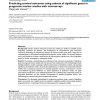BMCBI
2006
13 years 12 months ago
2006
Background: We describe Distill, a suite of servers for the prediction of protein structural features: secondary structure; relative solvent accessibility; contact density; backbo...
BMCBI
2006
13 years 12 months ago
2006
Background: Understanding gene regulatory networks has become one of the central research problems in bioinformatics. More than thirty algorithms have been proposed to identify DN...
BMCBI
2006
13 years 12 months ago
2006
Background: Diverse modeling approaches viz. neural networks and multiple regression have been followed to date for disease prediction in plant populations. However, due to their ...
BMCBI
2006
13 years 12 months ago
2006
Background: Prediction of human cell response to anti-cancer drugs (compounds) from microarray data is a challenging problem, due to the noise properties of microarrays as well as...
BMCBI
2006
2006
A Regression-based K nearest neighbor algorithm for gene function prediction from heterogeneous data
13 years 12 months ago
Background: As a variety of functional genomic and proteomic techniques become available, there is an increasing need for functional analysis methodologies that integrate heteroge...
BMCBI
2006
13 years 12 months ago
2006
Background: In recent years protein structure prediction methods using local structure information have shown promising improvements. The quality of new fold predictions has risen...
BMCBI
2006
13 years 12 months ago
2006
Background: Genetic markers hold great promise for refining our ability to establish precise prognostic prediction for diseases. The development of comprehensive gene expression m...
COMCOM
2008
13 years 12 months ago
2008
Wireless self-organizing networks such as mesh networks strive hard to get rid of mobility and radio propagation effects. Links
BMCBI
2008
13 years 12 months ago
2008
Background: Prediction of protein solvent accessibility, also called accessible surface area (ASA) prediction, is an important step for tertiary structure prediction directly from...
BMCBI
2008
13 years 12 months ago
2008
Background: Protein structure prediction methods provide accurate results when a homologous protein is predicted, while poorer predictions are obtained in the absence of homologou...




